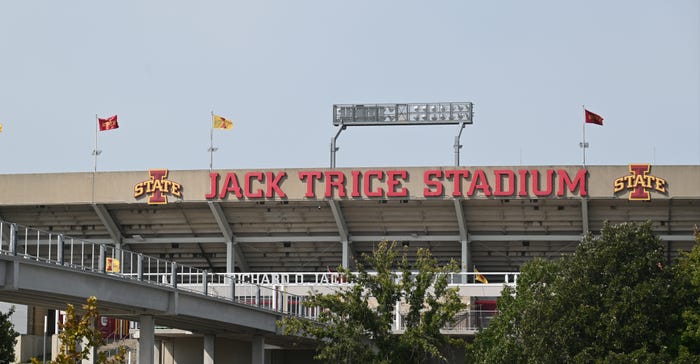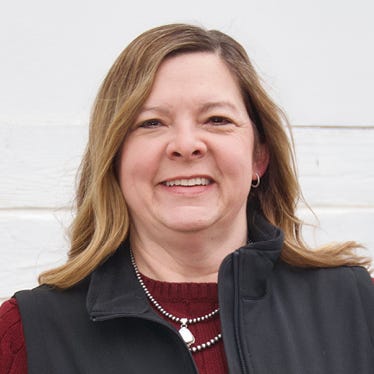September 23, 2022

Most fall Saturdays, the Iowa State Cyclone football team in Ames hits the gridiron to battle their opponents on a meticulously maintained, pristine field of grass. It’s a battle of might and strategy, closely watched and carefully dissected. But most folks don’t realize the work that goes into the field they’re playing on.
The Iowa State turf team spends more than 60 hours just painting the field for each game. Even before that, it took countless hours to get the grass just right. Adam Thoms, a turf grass specialist at Iowa State University, says the field at Jack Trice Stadium hasn’t always been natural turf.
“Prior to 1996, there was artificial turf here, and in 2008, the grass had to be replaced. So, for it to last 14 years this time was quite a feat. That took a lot of management, especially the last couple years,” Thoms says.
The new turf made everyone happy.
“The new playing surface at Jack Trice Stadium has been outstanding. It was the culmination of a lot of hard work by individuals and groups to create a surface for our players that looks great, but more importantly, is safe and will hold up throughout the season,” says ISU head football coach Matt Campbell. “We are fortunate to have one of the best natural grass fields in college football.”
Getting started
The natural grass playing field didn’t happen overnight. On April 30, 2021, Kentucky bluegrass was planted on 6 acres at the ISU Horticulture Research Station, north of Ames. It was their first time to grow the grass instead of buying sod from out of state. Master’s student Tom Gould oversaw growing the grass on ground previously used to grow corn.
“For the first four months it was growing, I think I looked at it six times each day. I knew this had to be managed correctly, especially the moisture,” he says. “It had to be able to grow on sand, kind of like growing grass on a perfectly wet beach.”
The soil conditions at the farm had to mimic that of the playing field, so 107 truckloads of sand were hauled from Omaha to provide a sand-capped soil for growing. It needed to hold the right amount of water to grow and establish the grass, but not so much water that it would kill the turf. It was irrigated, and additional seed and fertilizer was used as needed.
“Growing our own turf was something ISU hadn’t done before, and we had to be successful, or turf would have needed to be brought in from somewhere else,” Gould says. “And the expense would increase.”
Thoms says the use of Kentucky bluegrass, while not native to Iowa, was the best option because it grows up from the seed and not in clumps like many grasses. It is also a grass that can recover quickly — an important feature due to the wear and tear of a football game.
ISU’s manager of athletic turf and grounds, Josh Tvrdik, says they used three different cultivars of the Kentucky bluegrass to establish a better stand. Just over a year after they seeded the grass at the research station, they hired an outside firm to cut it and haul it a few miles down the road to the stadium.
“The actual process when the new turf was put in took about a week,” Tvrdik says. “The old turf had to be removed, and then the area had to be prepared for the new turf. We are fortunate to have the sod on the truck for such a short amount of time. It was cut and laid from farm to field within an hour, which meant it had less stress and could get established faster.”
Under the grass surface at the stadium is a 12-inch sand base and a gravel layer for better drainage. Once the 11 truckloads of sod were placed down, the team did some topdressing with sand to fill in the seams. They apply fertilizer twice a month and monitor daily to determine watering.
“We put down the new turf on May 2. It wasn’t just on the game field, but also two practice fields, so we used a lot of the 6 acres that was grown,” he adds.
Why natural grass?
Artificial turf has become more popular in recent years, even on high school fields that had sported natural grass for many years prior. Tvrdik says numerous research projects show the natural grass field is safer for athletes and causes fewer injuries, giving them better traction for start-and-stop plays and runs. He also says management and replacement costs on a natural grass field are lower than that of artificial turf.
“We play some games after the weather has started to turn colder. An artificial surface would be like playing on concrete,” he says, adding they must manage differently when the weather gets cold. “We use translucent tarps when the temps get colder to work like a greenhouse and provide the needed heat to keep the grass alive.”
Thoms says two of the best natural fields in the NFL are in the Upper Midwest and have and in-ground heating system to keep the grass alive even in the colder months. If the college schedule would change, they’d have to change their practices at Jack Trice Stadium.
On occasion, they have to put snow tarps down and remove snow to the corner hillsides before games. After each game, the team repairs the turf similarly to how they’d repair a golf course green. If needed, they can cut out a section and replace it with new turf.
“We also will overseed the field prior to the game. This allows the players to work the seed into the turf during play,” Thoms says. “This helps keep the grass well established, especially when we have several games in a row like we have this year.”
They use a rotary mower to mow the field three times each week to a 1.25-inch height. The team has to keep up that continual maintenance not just on the football game field, but also on the football practice fields, the softball field and the cross-country course. The university is switching soccer fields to natural turf next year, which will bring the total turf footprint at Iowa State to 80 acres.
“We wouldn’t be able to do all this without the team of around 10 students,” Tvrdik says. “Most of these students are in the turf program, but some are also agronomy students. The great thing about our program here is Adam teaches them in the classroom, and then they get hands-on experience working on our athletic fields.”
Thoms teaches classes about different grasses, weed identification and control, turf diseases, management plans, irrigation, and trouble-shooting. Math is also important to determine the pounds of a product or active ingredient needed for a specific area, which is determined in square feet instead of acres.
“It’s really like urban farming. We are taking soil tests, managing fertility and dealing with moisture challenges,” Thoms says.
“It’s all a science to keep the grass happy,” Tvrdik adds.
Game-day preparation
The week of a home game is when the extra work is set forward. They pattern-mow the field six to seven times in the same direction. Weather is the biggest challenge for the natural turf. Rain in the forecast? Tvrdik goes into planning mode.
“We don’t want to paint the field when the grass is wet, because the water-based paint won’t stick to the grass blades and it needs a good amount of time to dry,” he says.
A low-pressure setting on the paint sprayer is used so the paint lands just on the grass blades and can be mowed off as it grows. This also helps prevent the grass from dying.
Large volumes of paint are purchased because each game requires 210 gallons to paint the field lines. “We have a full crew when painting is happening, but [they] work around their classes since they can each only have 20 hours per week,” Tvrdik says. “It takes 60 man hours to get the painting done for each game, and depending on the weather, there are times we have to turn on the lights and work into the night.”
After the last game, they repair the field and blow out irrigation lines, and the grass rests until spring when the student team will get to work again.
Turf program
Giving the students in the turf grass program the hands-on experiences has been a key to success. Both Thoms and Tvrdik went through the program and understand what it takes to have a quality field. Several students have gone from being part of the turf team to work for professional football and baseball teams, other collegiate programs, or golf courses.
“We are always willing to introduce students to turf management and give several tours throughout the year,” Tvrdik says.
Thoms adds, “People always speak up if there’s a problem, but when the field is the best is when no one talks about it. That’s what we strive for and how we want these students to be when they get on their own.”
Now that the crew knows they can grow the needed grass at the university, they may not make the turf last as long as they did the last time. “We know there would be people out there who would love to have this kind of grass on their lawn. If we have a secondary market for the turf, we may replace it more often than every eight years,” Tvrdik adds.
About the Author(s)
You May Also Like






